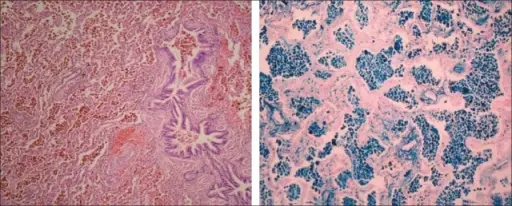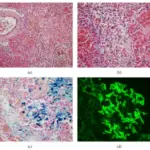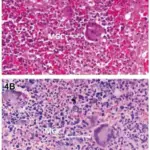Idiopathic pulmonary hemosiderosis is a medical condition characterized by increased episodes of bleeding in the intra-alveolar which in turn leads to increased accumulation of iron in form of hemosiderin.
What is the Pathology of Idiopathic Pulmonary Hemosiderosis?
The pathology of idiopathic pulmonary hemosiderosis is:
-Etiology: The cause of idiopathic pulmonary hemosiderosis is Early childhood age, presence of antibodies Anti-glomerular basement membrane antibody, acquired or congenital cardiopulmonary abnormalities, and infections e.g. pneumonia.
-Genes involved: None.
-Pathogenesis: The sequence of events that lead to idiopathic pulmonary hemosiderosis is divided into three categories. When there is the presence of circulating anti-GBM antibodies which leads to deposition of iron in the pulmonary system. When immune complexes are found in the pulmonary system example is in the Systemic Lupus erythematosus. The last category occurs with an unknown cause since none of the above causes are noted or found.
-Histology: The histology associated with idiopathic pulmonary hemosiderosis shows macrophages filled with hemosiderin, shedding, and hyperplasia of the alveolar epithelial cells.
How does Idiopathic Pulmonary Hemosiderosis Present?
Patients with idiopathic pulmonary hemosiderosis typically are of any age from the early neonatal ages to late adulthood. at age range of children 1-7 years. The symptoms, features, and clinical findings associated with idiopathic pulmonary hemosiderosis include Pallor and cyanosis due to increased blood loss, Tachypnea, Crackles, wheezing, and fever, in extreme cases there is growth retardation.
How is Idiopathic Pulmonary Hemosiderosis Diagnosed?
The diagnosis of Idiopathic Pulmonary Hemosiderosis is done through a series of blood workups imaging and at the time one can use lung biopsy. the clinical presentation of the patient also helps.
How is Idiopathic Pulmonary Hemosiderosis Treated?
this disease, Idiopathic Pulmonary Hemosiderosis is treated according to the symptoms that present and also as a long-term therapy. It includes oxygen supplementation, blood transfusion in case of shock mechanical ventilation, and immunosuppressive therapy. medical treatment options are the use of corticosteroids.
What is the Prognosis of Idiopathic Pulmonary Hemosiderosis?
The prognosis of idiopathic pulmonary hemosiderosis is fair with a mean survival rate of 3-5 years which is 86% survival rate.



